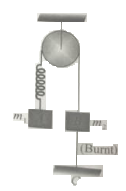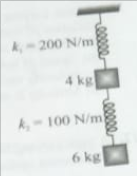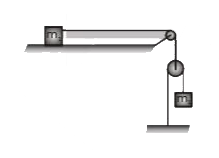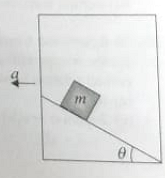When forces act on a particle remains in equilibrium. If is now removed then acceleration of the particle is
1.
2.
3.
4.
A force produces an acceleration of \(4~\text{m/s}^2\) in body of mass \(m_1\) and the same force produces an acceleration of \(6~\text{m/s}^2\) on a mass \(m_2\). If the force is applied to a body of mass \(m_1+m_2\), its acceleration will be \(a\). Then:
1. \(\frac{m_1}{m_2}= \frac{4}{3}\)
2. \(\frac{m_1}{m_2}= \frac{2}{3}\)
3. \(a= 2.4~\text{m/s}^2\)
4. \(a= 5.4~\text{m/s}^2\)
In the system shown . System is held at rest by thread BC. Just after lower thread is Burnt.
1. Acceleration of is upward
2. Magnitude of acceleration of both blocks will be
3. Acceleration of will be non-zero
4. Magnitude of acceleration of two blocks will be non-zero and unequal.
Two blocks of 4 kg and 6 kg are attached by springs, they are hanging in vertical position, lower spring breaks due to excessive force. Acceleration of 4 kg block just after breaking
1. 15
2. 25
3. 10
4. Zero
A particle of mass 2 kg is initially at rest. A force acts on it whose magnitude varies with time as in the figure. The velocity of the particle after 10 s is 
1. 20
2. 75
3. 26
4. 50
The maximum value of the block for which the system will remain in equilibrium (coefficient of friction between block and plane surface is ), is 
1.
2.
3.
4.
In the given figure the coefficient of friction between the two blocks is , and all other surface is smooth. Find the minimum value of F which will prevent
1.
2.
3.
4.
A block of mass 0.5 kg is pulled by 12 N force on a fixed block. Speed of block is constant. Find total contact force applied by lower block on upper block
1. 12 N
2. 5 N
3. 13 N
4. 17 N
A block is sliding along incline as shown in figure. If the acceleration of chamber is a as shown in the figure. The time required to cover a distance L along incline is :
1.
2.
3.
4.
A block is resting on a horizontal plete in the x-y plane and the coefficient of friction between the block and the plate is . The plate begins to move in the x-direction and its velocity is being the time and b being a constant. At what time will the block start sliding on the plate?
1.
2.
3.
4.
Two blocks A and B each of mass m are placed on a smooth horizontal surface. Two horizontal force F and 2F are applied on the two blocks A and B respectively as shown in figure. The block A does not slide on block B. Then the normal reaction acting between the two blocks is
1. F
2.
3.
4. 3F
Consider the situation shown in figure. All the surfaces are smooth. The tension in the string connected to 2 m is 
1.
2.
3.
4. mg
The tension in the spring is
1. Zero
2. 2.5 N
3. 5 N
4. 10 N
A horizontal force F of variable magnitude and constant direction acts on a body of mass m which is initially at rest at a point O on a smooth horizontal surface. The magnitude of F is given by where t is the time for which the force has been acting on the body and are positive constants. If s is the distance of the body from O at time t, then s is equal to
1.
2.
3.
4.
A hockey player is moving nothward and suddenly turns westward with the same speed to avoid an opponent. The force that acts on the player is
1. frictional force along westward.
2. muscle force along southward.
3. frictional force along south-west.
4. muscle force along south-west.
Assertion : A rocket moves forward by pushing the surrounding air backwards.
Reason : It derives the necessary thrust to move forward according to Newton's third law of motion.
Assertion : The driver in a vehicle moving with a constant speed on straight road is in a non-inertial frame of reference.
Reason : A reference frame in which Newton's laws of motion are applicable is non-inertial.
Assertion : Use of ball bearings between two moving parts of machine is a common practice.
Reason : Ball bearings reduce vibrations and provide good stability.
Assertion : Two bodies of masses M and m(M>m) are allowed to fall from the same height if the air resistance for each be the same then both the bodies will reach the earth simultanoeously.
Reason : For same air resistance, acceleration of both the bodies will be same.
Assertion : Static friction is a self-adjusting force.
Reason : Kinetic friction does depend upon mass of the body.